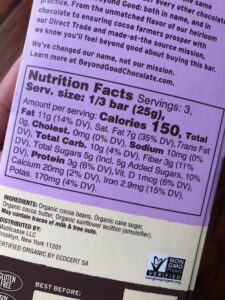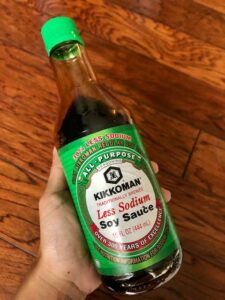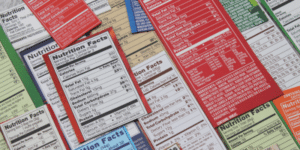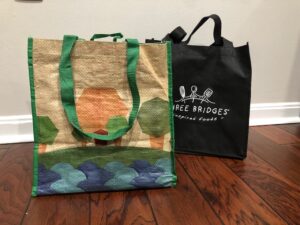When shopping for groceries or grabbing a quick snack, we are often faced with many options, but how do we choose the option that best suits us? In this blog post, we’ll explore how food labels can help us make more informed decisions as consumers. We’ll delve into:
- What food labels mean
- How food labels can impact our grocery runs
- How we can use food labels to find nourishment.
Food Labels and the Practice of Conscious Eating
In a previous post in this series, we discussed the benefits of seasonal eating. For many people, seasonal eating may be challenging. However, we can still practice conscious eating habits by taking advantage of the information provided by food labels.
Nutrition labels are required on most foods by the Food and Drug Administration (FDA). They provide consumers with information about the nutritional content of a food item (1). As effective tools in practicing conscious eating, they give us a glimpse into what makes up our food. These labels provide us with information about what ingredients are in our food and also help us understand how certain foods can nourish us.

Anatomy of a Nutrition Label
Most of us have turned over a box of cereal or a granola bar only to find a slew of numbers and percentages. When confronted with many options of the same item, food labels are helpful in understanding how different foods can fit our nutritional needs.
Nutrition labels provide information on:
- Serving size
- Calories
- Nutritional content.
These labels typically highlight specific nutrients. Also providing further information on how a particular nutrient in a food product can contribute to our daily intake.
Serving Sizes
Serving sizes are based on the amount an individual typically consumes of a given food. They are not a recommendation of how much someone should eat (2). Individual serving sizes can vary among different people. Therefore, the serving size presented may not necessarily be the amount that serves us. With this in mind, we can be more aware of what a serving size means to us individually.
Calories
The number of calories listed on a label reflects the typical serving size consumed. Calories are based on the serving size. By knowing our individual daily calorie needs we can sense how a serving size contributes to our nutritional intake (3).
Most food labels are based on a 2000 calorie diet. However, for many of us, we may need more or fewer calories. As a result, a single serving can contribute differently to our individual caloric intake.
Nutritional content
After serving sizes and calories, nutrition labels list a percent daily value next to each nutrient. Percent Daily Values (%DV) allow us to understand how much of a specific nutrient a food will provide us in a day.
In general, the FDA deems any food with a nutrient with a %DV of:
- 20% or more as high
- 5% or less as low (4).
Using this information can help us make more informed decisions about which foods will serve our individual nutritional needs. Keep this in mind when comparing different products and opt for the item that provides more of a specific nutrient needed to nourish us.
Understanding Nutrient Content Claims
By understanding the basic structure of food labels, we can better navigate the various food claims on different packages as well. You may have browsed through an aisle of packaged foods and seen nutrient content claims labeled as:
- Low fat
- Sugar-free
- Low cholesterol.
These labels highlight the level of a nutrient in a particular food product (5).
Each nutrient may have a different content threshold in determining what is considered free, low, high, reduced, etc. These criteria are defined by the FDA and foods must be authorized in order to have such labeling.
Since nutrient content claims vary among different foods, it is helpful to have a basic understanding of what these claims mean.
FDA Food and Dietary Supplement Labels (6):
| LABEL | MEANING |
| FREE | Very small amount of a specific nutrient |
| LOW | Bit higher nutrient content than foods labeled FREE but have low nutrient content based on FDA guidelines |
| REDUCED OR MORE | Comparing one food product to another |
For more information on nutrient content claims for specific nutrients, check out the FDA’s Guidance for Industry: Food Labeling Guide (7).
Applying our knowledge of food labels helps us understand what a food claims to offer nutrient-wise. As a result, we can take this information to make more informed choices that serve our individual dietary needs.
Using Food Labels
 By understanding food labels, we can practice conscious eating habits while shopping for our groceries. They are tools that assist us in making more informed decisions about what foods best serve us.
By understanding food labels, we can practice conscious eating habits while shopping for our groceries. They are tools that assist us in making more informed decisions about what foods best serve us.
Food labels can help us stay aware of how foods impact or contribute to our nutritional needs differently. However, since every individual has unique nutritional needs, it is important to use these labels as a tool.
If needed, seek nutritional assistance from a medical professional to better understand your individual daily calorie intake as well as what nutritional needs you may have.
Sources:
- Nutrition Facts: A guide to food labels, https://www.mayoclinic.org/healthy-lifestyle/nutrition-and-healthy-eating/in-depth/nutrition-facts/art-20048426
- Serving Size on the New Nutrition Facts Label, https://www.fda.gov/food/new-nutrition-facts-label/serving-size-new-nutrition-facts-label
- Food Label Tip: Watch Your Calories and Serving Sizes, https://www.nhlbi.nih.gov/health/educational/healthdisp/pdf/tipsheets/Food-Label-Tip-Watch-Your-Calories-and-Serving-Sizes.pdf
- How to Understand and Use the Nutrition Facts Label, https://www.fda.gov/food/new-nutrition-facts-label/how-understand-and-use-nutrition-facts-label
- Label Claims for Conventional Foods and Dietary Supplements, https://www.fda.gov/food/food-labeling-nutrition/label-claims-conventional-foods-and-dietary-supplements
- Food Packaging Claims, https://www.heart.org/en/healthy-living/healthy-eating/eat-smart/nutrition-basics/food-packaging-claims
- Guidance for Industry: Food Labeling Guide, https://www.fda.gov/regulatory-information/search-fda-guidance-documents/guidance-industry-food-labeling-guide



